Identification of a Critical Time with Acoustic Emission Monitoring during Static Fatigue Tests on Ceramic Matrix Composites: Towards Lifetime Prediction †
Abstract
:1. Introduction
2. Experimental Procedure
2.1. Material

2.2. Static Fatigue Tests
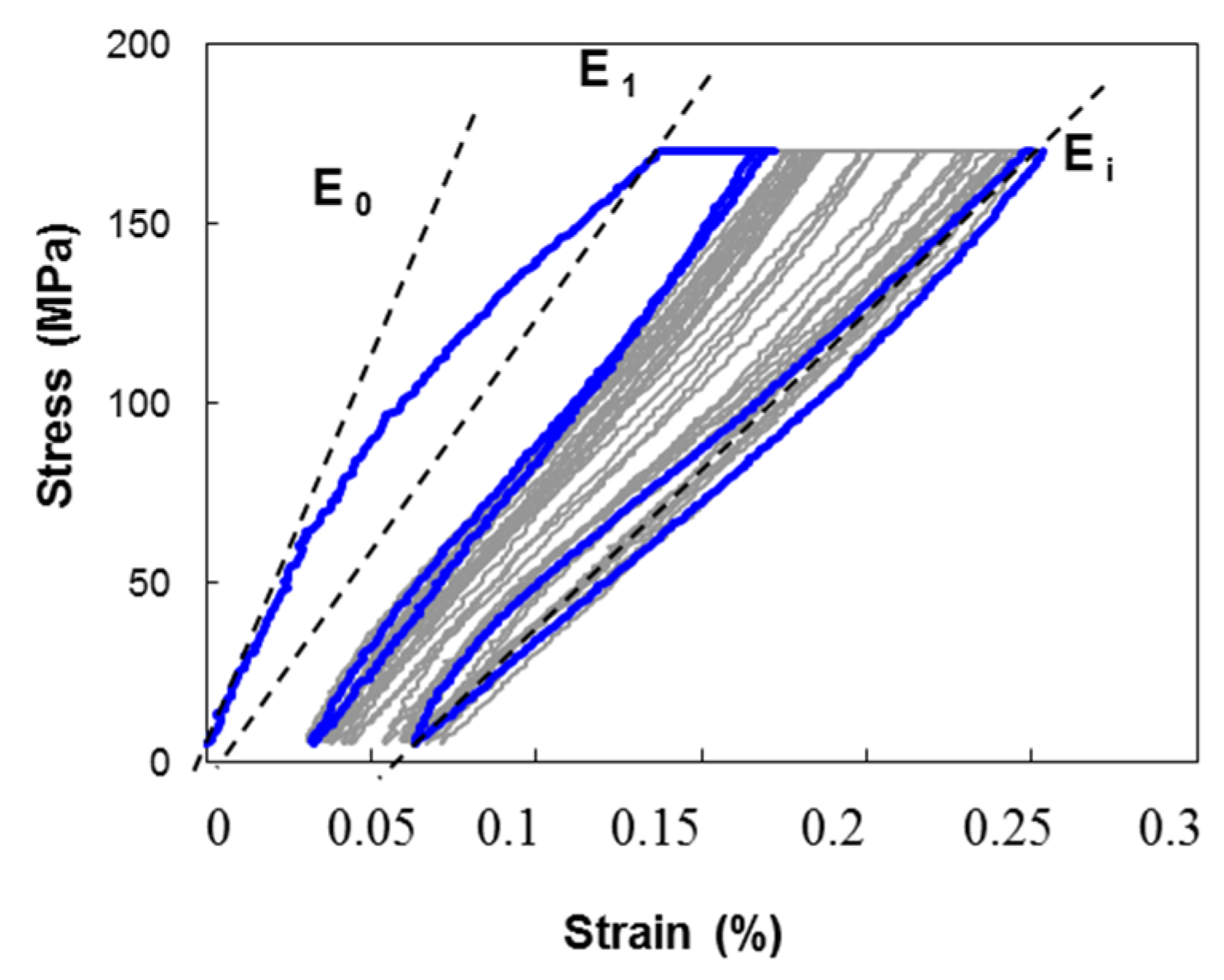
2.3. Acoustic Emission Monitoring
3. Acoustic Emission Analysis
3.1. Definition of the Acoustic Energy
3.2. Attenuation Coefficient B
3.3. Coefficient of Emission RAE
3.4. Power Law
3.5. Identification of Damage Mechanisms with Supervised Clustering
4. Results and Discussion
4.1. Mechanical Analysis
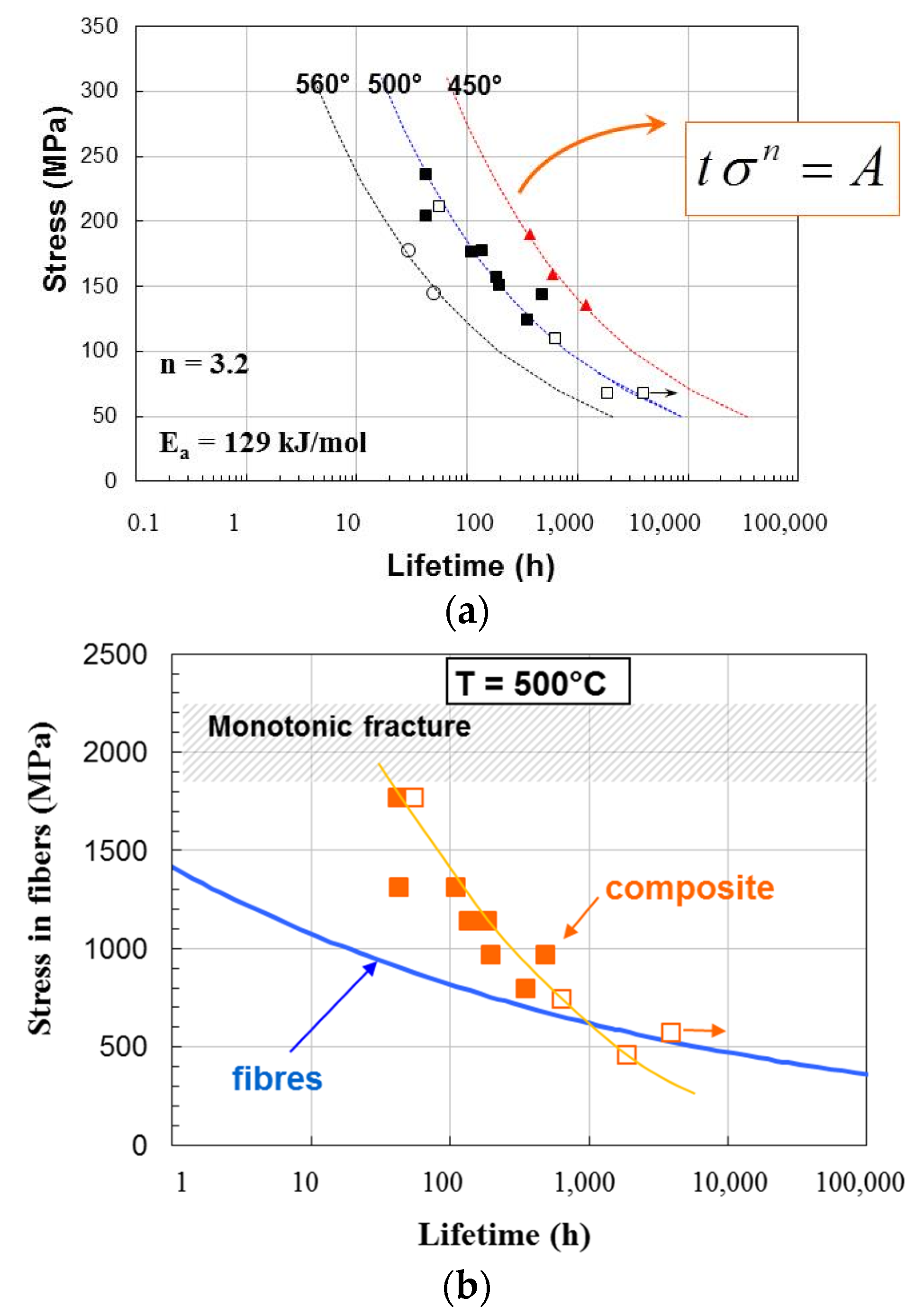
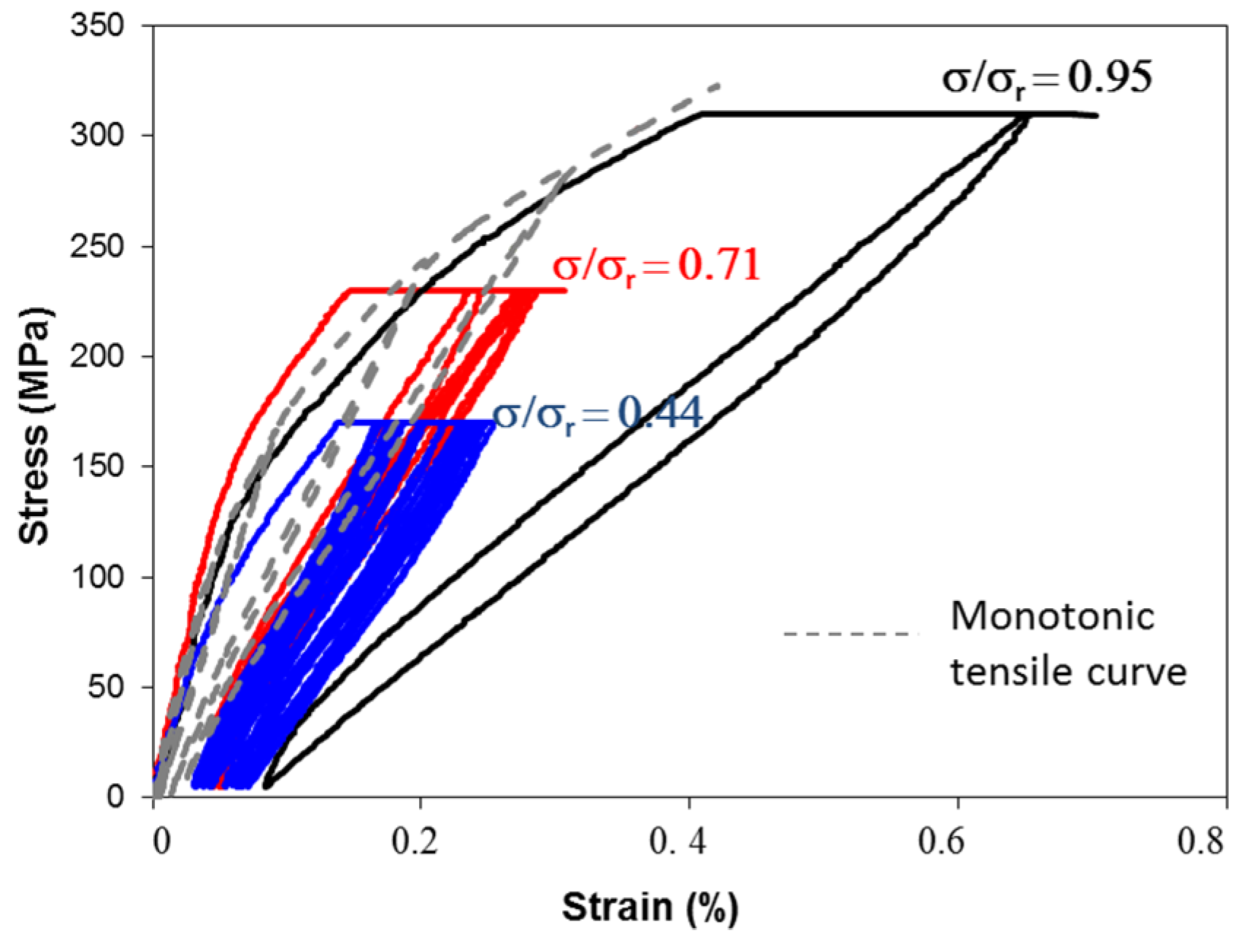
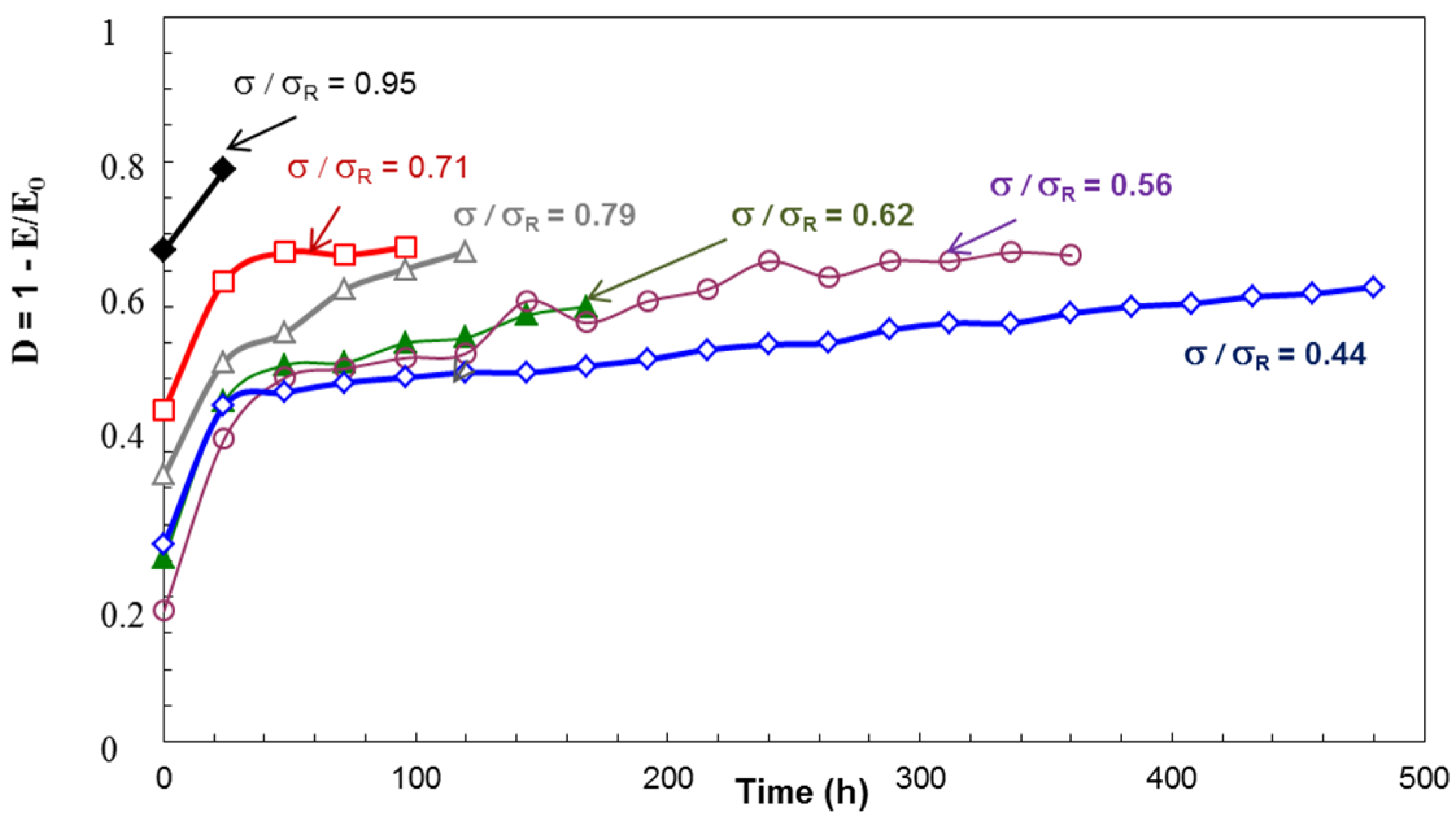

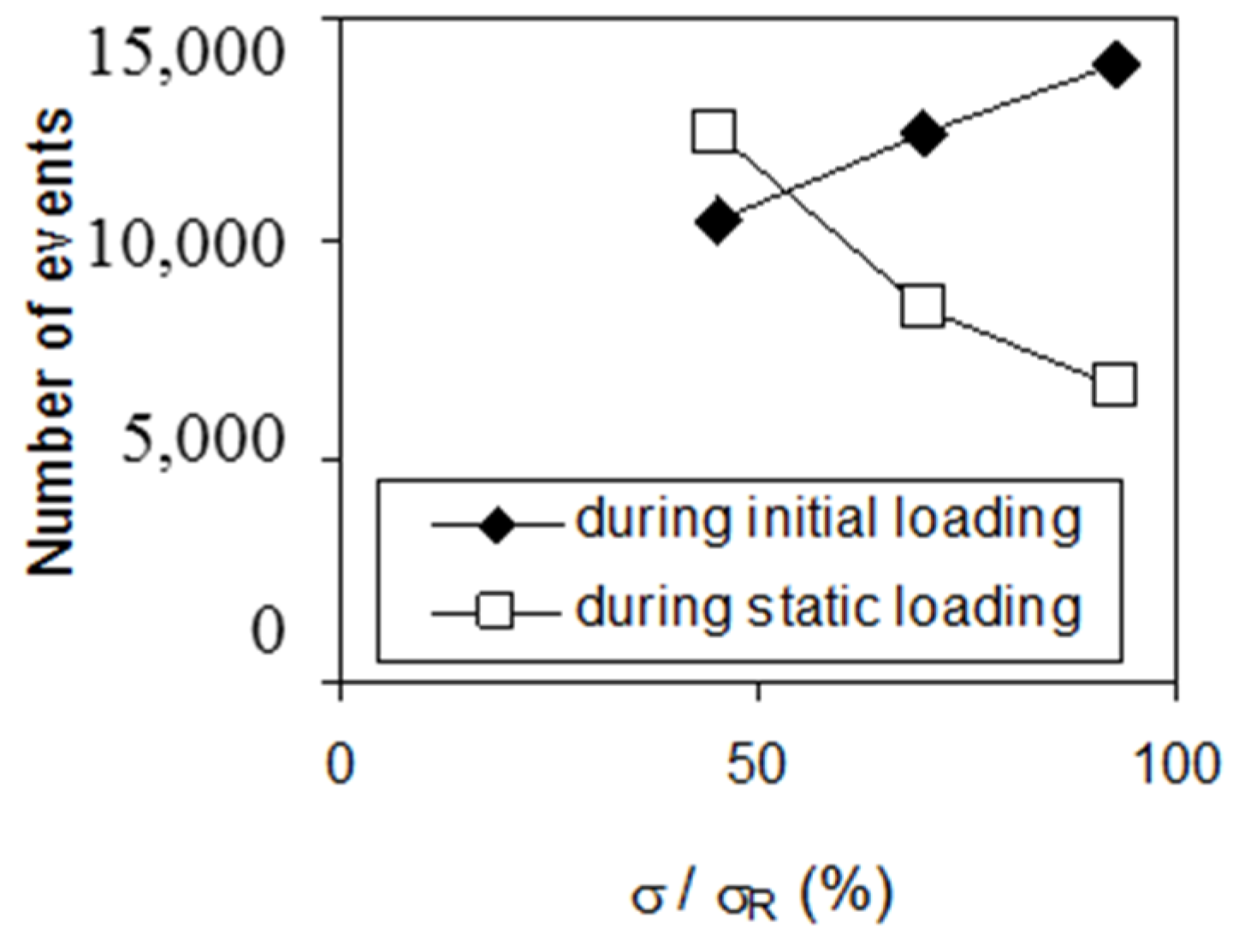
4.2. Identification of Critical Time
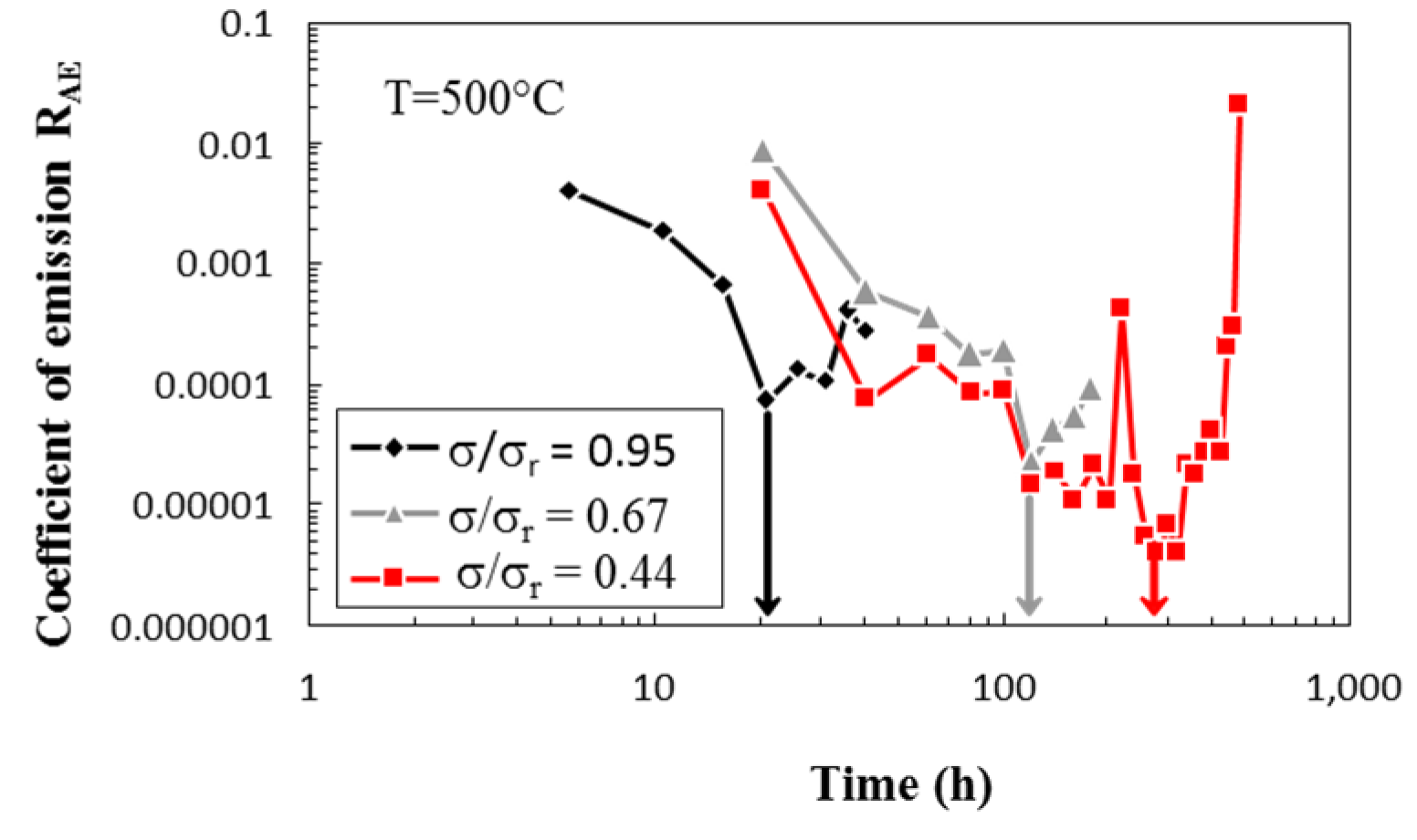
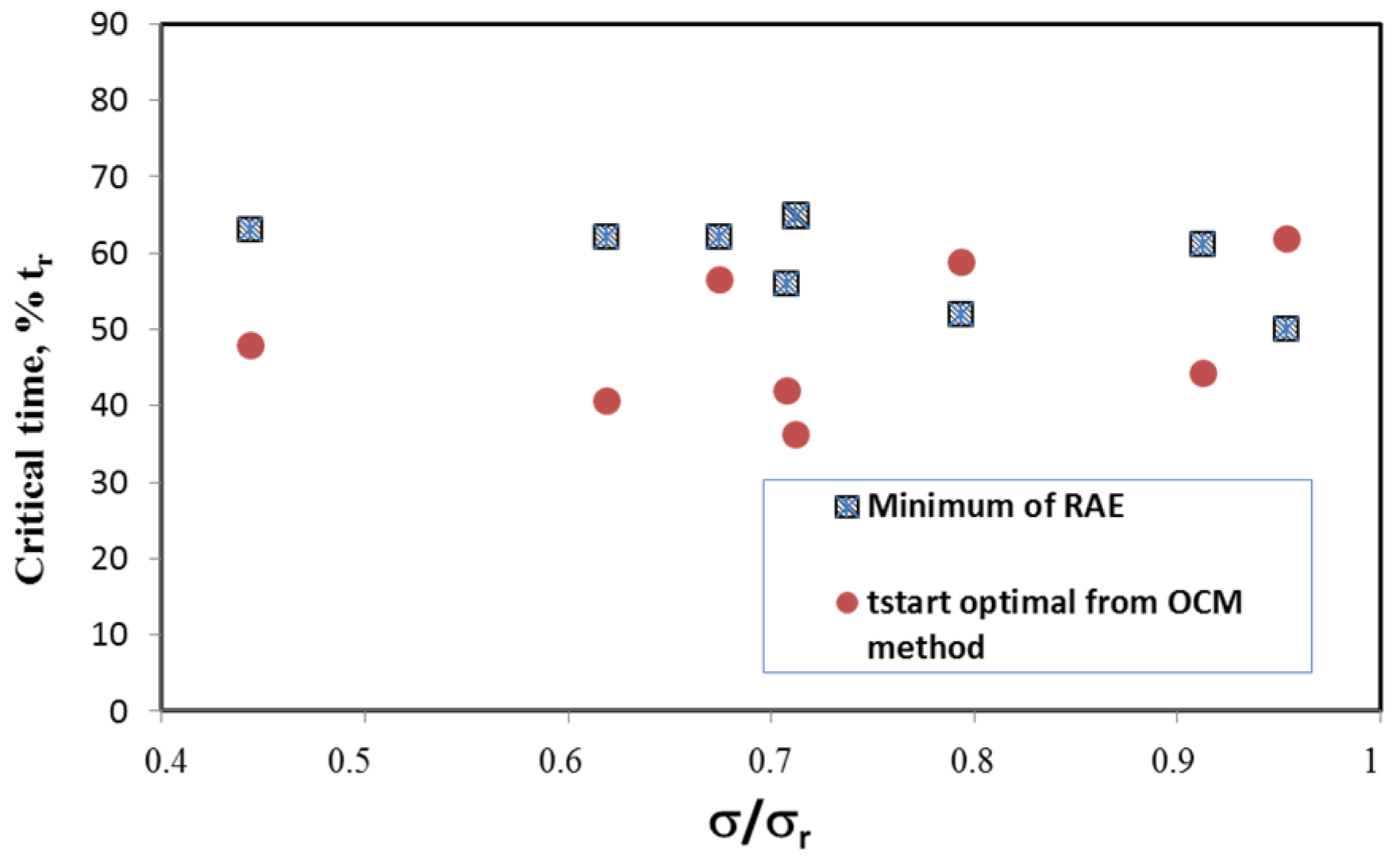
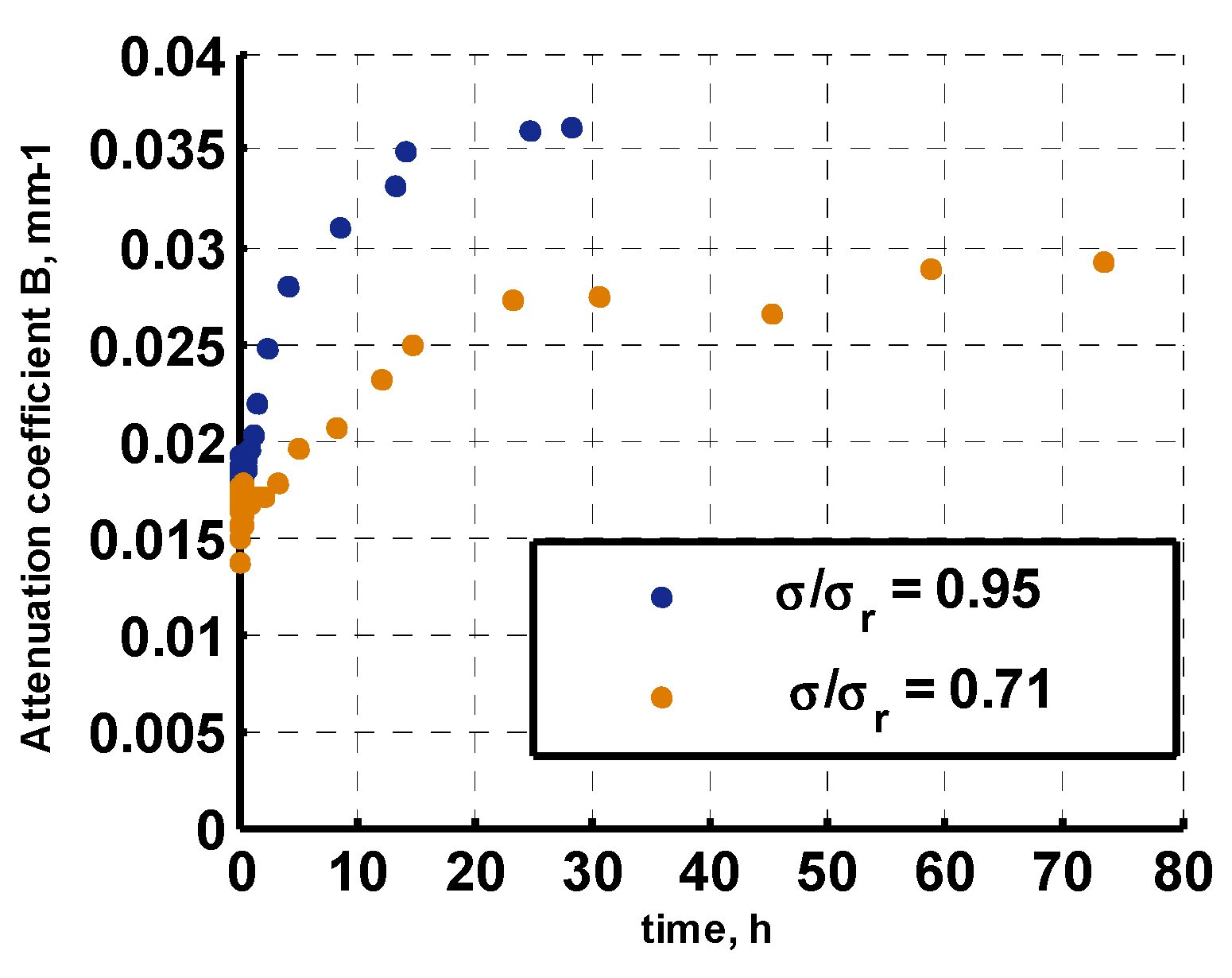
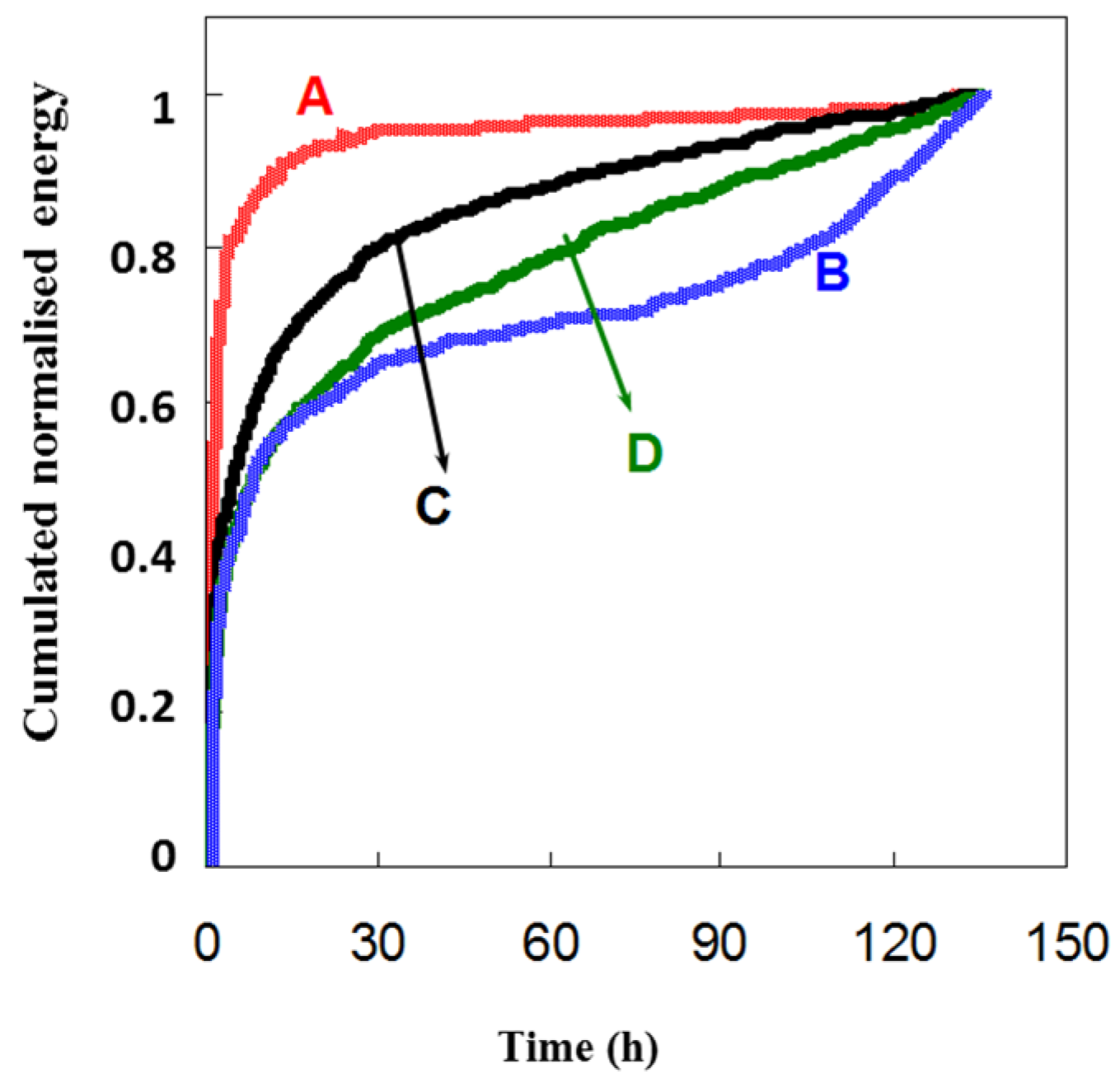
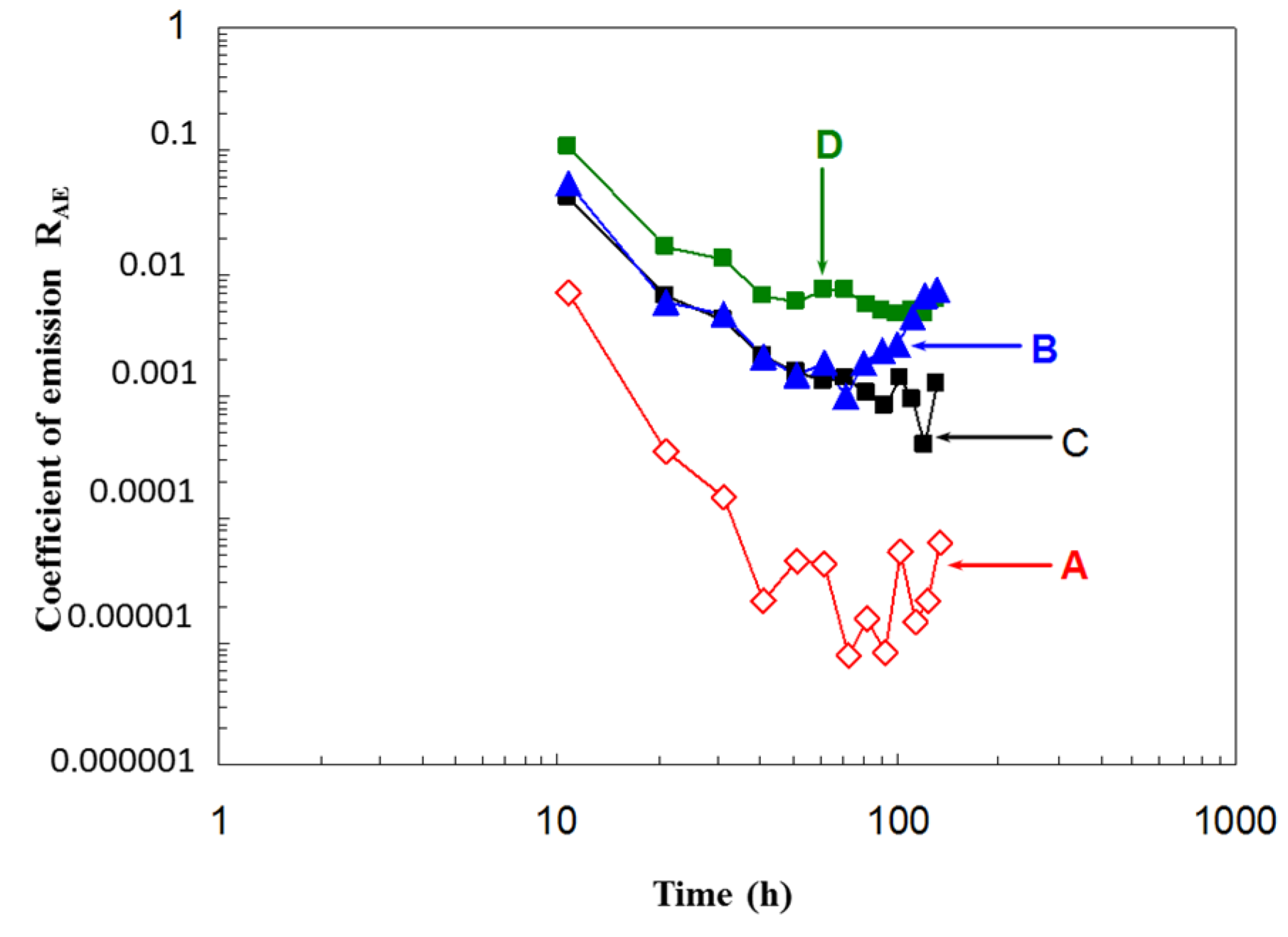
4.3. Toward Lifetime Prediction
5. Conclusions
Acknowledgment
Author Contributions
Conflicts of Interest
References
- Fantozzi, G.; Reynaud, P.; Rouby, D. Thermomechanical behaviour of long fibres ceramic-ceramic composites. Silic. Ind. 2002, 66, 109–119. [Google Scholar]
- Reynaud, P.; Rouby, D.; Fantozzi, G. Effects of temperature and of oxidation on the interfacial shear stress between fibres and matrix in ceramic-matrix composites. Acta Mater. 1998, 46, 2461–2469. [Google Scholar] [CrossRef]
- Naslain, R.; Christin, F. Sic-matrix composite materials for advanced jet engines. MRS Bull. 2003, 28, 654–658. [Google Scholar] [CrossRef]
- Lamon, J. Micromechanics-based approach to the mechanical behavior of brittle matrix composites. Compos. Sci. Technol. 2002, 58, 2259–2272. [Google Scholar] [CrossRef]
- Ohnabe, H.; Masaki, S.; Onozuka, M.; Miyahara, K.; Sasa, T. Potential applications of ceramic matrix composites to aero-engine components. Compos. A 1999, 30, 489–496. [Google Scholar] [CrossRef]
- Lamon, J. CVI SiC/SiC composites. In Handbook of Ceramics Composites; Bansal, N.P., Ed.; Springer: Berlin, Germany, 2005; pp. 55–76. [Google Scholar]
- Fantozzi, G.; Reynaud, P. Mechanical behaviour of SiC fiber reinforced ceramic matrix composites. In Comprehensive Hard Materials; Sarin, V.K., Ed.; Elsevier: Philadelphia, PA, USA, 2014; pp. 345–366. [Google Scholar]
- Quemard, L.; Rebillat, F.; Guette, A.; Tawil, H.; Louchet-Pouillerie, C. Self-healing mechanisms of a SiC fiber reinforced multi-layered ceramic matrix composite in high pressure steam environments. J. Eur. Ceram. Soc. 2007, 27, 2085–2094. [Google Scholar] [CrossRef]
- Forio, P.; Lamon, J. Fatigue behavior at high temperatures in air of a 2D SiC/SiBC composite with a self-sealing multilayered matrix. In Ceram Transactions; Bansal, N.P., Singh, J.P., Lin, H.T., Eds.; American Ceramic Society: Westerville, OH, USA, 2001; Volume 128, pp. 127–141. [Google Scholar]
- Ono, K.; Huang, Q. Pattern Recognition Analysis of Acoustic Emission Signals. NDT and E Int. 1997, 30, 109. [Google Scholar]
- Yan, T.; Holford, K.; Carter, D.; Brandon, J. Classification of acoustic emission signatures using a self-organization neural network. J. Acoust. Emiss. 1999, 17, 49–59. [Google Scholar]
- Kostopoulos, V.; Loutas, T.H.; Kontsos, A.; Sotiriadis, G.; Pappas, Y.Z. On the identification of the failure mechanisms in oxide/oxide composites using acoustic emission. NDT E Int. 2003, 36, 571–580. [Google Scholar] [CrossRef]
- Pappas, Y.Z.; Kontsos, A.; Loutas, T.H.; Kostopoulos, V. Failure mechanisms analysis of 2D carbon/carbon using acoustic emission monitoring. NDT E Int. 1998, 31, 571–580. [Google Scholar] [CrossRef]
- Godin, N.; Huguet, S.; Gaertner, R. Integration of the Kohonen’s self-organising map and k-means algorithm for the segmentation of the AE data collected during tensile tests on cross-ply composites. NDT E Int. 2005, 38, 299–309. [Google Scholar] [CrossRef]
- Moevus, M.; Rouby, D.; Godin, N.; R’Mili, M.; Reynaud, P.; Fantozzi, G.; Fayolle, G. Analyse of damage mechanisms and associated acoustic emission in two SiC/[Si-B-C] composites exhibiting different tensile curves. Part I: Damage patterns and acoustic emission activity. Compos. Sci. Technol. 2008, 68, 1250–1257. [Google Scholar] [CrossRef]
- Moevus, M.; Godin, N.; Rouby, D.; R’Mili, M.; Reynaud, P.; Fantozzi, G.; Farizy, G. Analyse of damage mechanisms and associated acoustic emission in two SiC/[Si-B-C] composites exhibiting different tensile curves. Part II: Unsupervised acoustic emission data clustering. Compos. Sci. Technol. 2008, 68, 1258–1265. [Google Scholar] [CrossRef]
- Smith, R.L.; Phoenix, S.L. Asymptotic distributions for the failure of fibrous materials under series-parallel structure and equal load-sharing. J. Appl. Mech. 1981, 48, 75–82. [Google Scholar] [CrossRef]
- Curtin, W.A. Theory of mechanical properties of ceramic-matrix composites. J. Am. Ceram. Soc. 1991, 74, 2837–2845. [Google Scholar] [CrossRef]
- Newman, W.I.; Phoenix, S.L. Time dependent fiber-bundles with local load sharing. Phys. Rev. E Stat. Nonlin. Soft Matter Phys. 2001, 63, 021507. [Google Scholar] [CrossRef] [PubMed]
- Turcotte, D.; Shcherbakov, R. Can damage mechanics explain temporal scaling laws in brittle fracture and seismicity? Pure Appl. Geophys. 2006, 163, 1031–1045. [Google Scholar] [CrossRef]
- Guarino, A.; Garcimartin, A.; Ciliberto, S. An experimental test of the critical behaviour of fracture precursors. Eur. Phys. J. B 1998, 6, 13–24. [Google Scholar] [CrossRef]
- Nechad, H.; Helmstetter, A.; El Guerjouma, R.; Sornette, D. Andrade and critical time-to-failure laws in fiber-matrix composites: Experiments and model. J. Mech. Phys. Solids 2005, 53, 1099–1027. [Google Scholar] [CrossRef]
- Deschanel, S.; Vanel, L.; Vigier, G.; Godin, N.; Ciliberto, S. Experimental study of crackling noise: Conditions on power law scaling correlated to fracture precursors. J. Stat. Mech. Theory Exp. 2009. [Google Scholar] [CrossRef]
- Shaira, M.; Godin, N.; Guy, P.; Vanel, L.; Courbon, J. Evaluation of the strain-induced martensitic transformation by acoustic emission monitoring in 304L austenitic stainless steel: Identification of the AE signature of the martensitic transformation and power-law statistics. Mater. Sci. Eng. A 2008, 492, 392–399. [Google Scholar] [CrossRef]
- Morscher, G.N. The velocity and attenuation of acoustic emission waves in SiC/SiC composites loaded in tension. Compos. Sci. Technol. 2002, 62, 1171–1180. [Google Scholar] [CrossRef]
- Maillet, E.; Godin, N.; R’Mili, M.; Reynaud, P.; Lamon, J.; Fantozzi, G. Analysis of Acoustic Emission energy release during static fatigue tests at intermediate temperatures on Ceramic Matrix Composites: Towards rupture time prediction. Compos. Sci. Technol. 2012, 72, 1001–1007. [Google Scholar] [CrossRef]
- Maillet, E.; Godin, N.; R’Mili, M.; Reynaud, P.; Lamon, J.; Fantozzi, G. Determination of acoustic emission sources energy and application towards lifetime prediction of ceramic matrix composites. In Mechanical Properties and Performance of Engineering Ceramics and Composites VII; Singh, D., Salem, J., Halbig, M., Mathur, S., Eds.; Wiley: Hoboken, NJ, USA, 2012; Volume 33, pp. 15–25. [Google Scholar]
- Maillet, E.; Godin, N.; R’Mili, M.; Reynaud, P.; Fantozzi, G.; Lamon, J. Real-time evaluation of energy attenuation: A novel approach to acoustic emission analysis for damage monitoring of ceramic matrix composites. J. Eur. Ceram. Soc. 2014, 34, 1673–1679. [Google Scholar] [CrossRef]
- Momon, S.; Moevus, M.; Godin, N.; R’Mili, M.; Reynaud, P.; Fantozzi, G.; Fayolle, G. Acoustic emission and lifetime prediction during static fatigue tests on ceramic-matrix-composite at high temperature under air. Compos. A Appl. Sci. Manuf. 2010, 41, 913–918. [Google Scholar] [CrossRef]
- Bufe, C.G.; Varnes, D.G. Predictive modeling of the seismic cycle of the Greater San Francisco Bay Region. J. Geophys. Res. 1993, 98, 9871–9883. [Google Scholar] [CrossRef]
- Bowman, D.D.; Ouillon, G.; Sammis, C.G.; Sornette, A.; Sornette, D. An observational test of the critical earthquake concept. J. Geophys. Res. 1998, 103, 24359–24372. [Google Scholar] [CrossRef]
- Likas, A.; Vlassis, N.; Verbeek, J. The global k-means clustering algorithm. Pattern Recognit. 2003, 36, 451–461. [Google Scholar] [CrossRef]
- Lee, M.S.; Keerthi, S.; Jin Ong, C.; Decoste, D. An efficient method for computing leave one out error in support vector machines with gaussian kernels. IEEE Trans. Neural Netw. 2004, 15, 750–757. [Google Scholar] [CrossRef] [PubMed]
- Gauthier, W.; Lamon, J. Delayed failure of Hi-Nicalon and Hi-Nicalon S multifilament tows and single filaments at intermediate temperatures. J. Am. Ceram. Soc. 2009, 92, 702–709. [Google Scholar] [CrossRef]
© 2016 by the authors; licensee MDPI, Basel, Switzerland. This article is an open access article distributed under the terms and conditions of the Creative Commons by Attribution (CC-BY) license (http://creativecommons.org/licenses/by/4.0/).
Share and Cite
Godin, N.; Reynaud, P.; R’Mili, M.; Fantozzi, G. Identification of a Critical Time with Acoustic Emission Monitoring during Static Fatigue Tests on Ceramic Matrix Composites: Towards Lifetime Prediction. Appl. Sci. 2016, 6, 43. https://doi.org/10.3390/app6020043
Godin N, Reynaud P, R’Mili M, Fantozzi G. Identification of a Critical Time with Acoustic Emission Monitoring during Static Fatigue Tests on Ceramic Matrix Composites: Towards Lifetime Prediction. Applied Sciences. 2016; 6(2):43. https://doi.org/10.3390/app6020043
Chicago/Turabian StyleGodin, Nathalie, Pascal Reynaud, Mohamed R’Mili, and Gilbert Fantozzi. 2016. "Identification of a Critical Time with Acoustic Emission Monitoring during Static Fatigue Tests on Ceramic Matrix Composites: Towards Lifetime Prediction" Applied Sciences 6, no. 2: 43. https://doi.org/10.3390/app6020043
APA StyleGodin, N., Reynaud, P., R’Mili, M., & Fantozzi, G. (2016). Identification of a Critical Time with Acoustic Emission Monitoring during Static Fatigue Tests on Ceramic Matrix Composites: Towards Lifetime Prediction. Applied Sciences, 6(2), 43. https://doi.org/10.3390/app6020043






